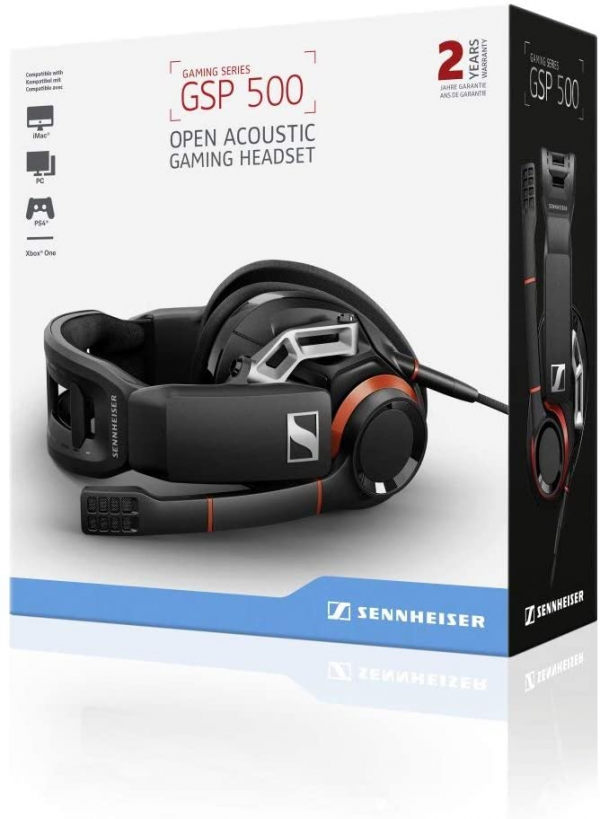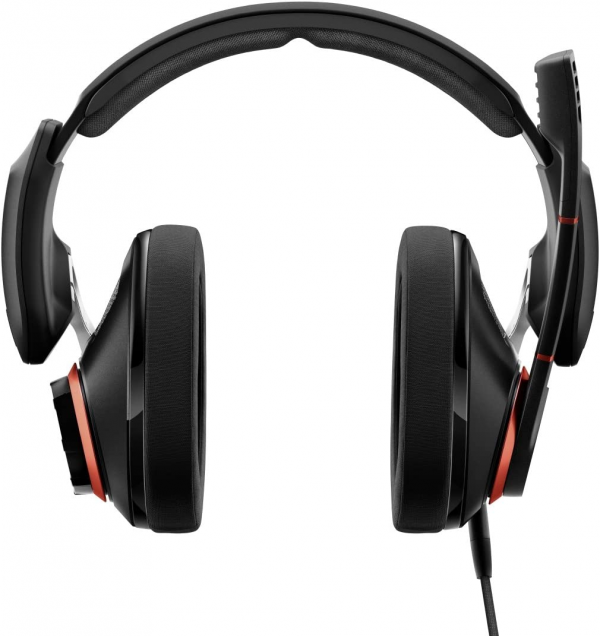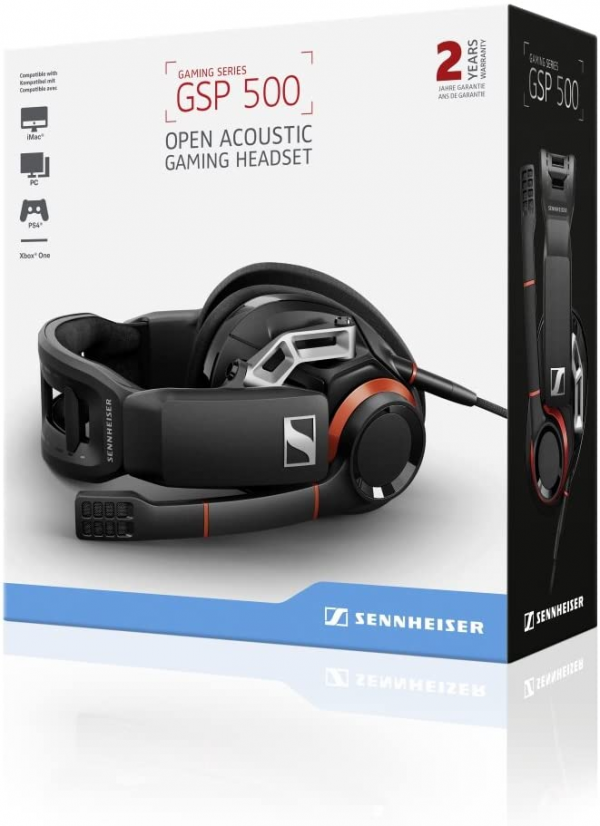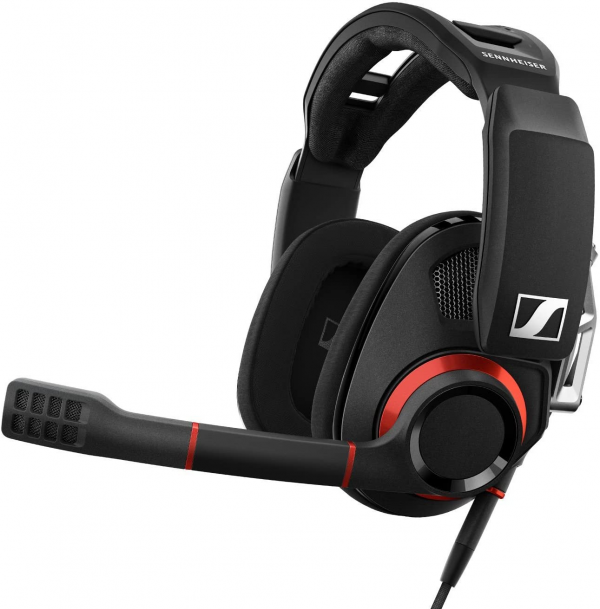Sennheiser
Sennheiser GSP 500 gaming headset: the king of spatialization
Aprox. 326€ - see price -
The GSP 500 is part of the new range of high-end gaming headsets from Sennheiser, also made up of its almost twin brother, the GSP 600. If the second is a closed headset, the first, which interests us here, is an open headset which promises therefore to exchange the excellent sound insulation of his brother for a larger sound reproduction. Let's see what it is.
Our review
Ergonomics
If the GSP 500 does not stricto sensu the same design as the GSP 600, distinguishing the two cattle is still a game of the seven errors relatively difficult. All of the comments we made to one therefore apply to the other. Without letting go of the garish visual effects common to many gaming headsets, this one still sports a massive plastic and assertive personality, which does not go unnoticed.
Nothing new to say either on the assembly side, of a perfectly equivalent quality. Comfort, on the other hand, inspires us with a few small reservations, although it remains very good in absolute terms: the wide and deep ear cups easily accommodate even the largest ear flaps, and the wide headband distributes with great the weight of the helmet (358 g) over the entire extent of the skull. However, it is difficult to justify the excessive force with which the atria press on the temples and the base of the jaw.
On the GSP 600, this pressure had the counterpart of ensuring excellent sound insulation, but this insulation is by definition absent in the case of this GSP 500 with an open acoustic design. Worse, the latter was strangely equipped with harder pads than those of the GSP 600, making the pressure even more sensitive. The bars for adjusting the tension of the headband certainly allow this defect to be reduced, but to an alas insufficient degree, especially for large heads.
The helmet is supplied with two detachable cables. The first, 1.5 m long, is finished with a 4-point mini-jack that can be used with a game console (PS4, Xbox One or Switch), a mobile device or a laptop with a microphone combo jack / helmet. The second extends over 2.5 m, and ends with two 3-point mini-jack, therefore allowing connection to a more traditional PC sound card. On the headset side, the cable connection is unfortunately made by a proprietary connector, which therefore prevents the use of a third-party cable. Pity.
Adjustment of the listening volume is done via a wheel integrated into the left ear cup. As always, we deplore this placement directly on the helmet: assuming that the potentiometer experiences bad days and ends up "spitting", it would then make the helmet unusable. If it had been placed on the cable, a simple replacement of the cable would have been enough to correct the problem ...

Audio
The GSP 500 offers a sound with characteristics quite typical of Sennheiser: by no means perfect or transparent, it still manages to produce a listening experience that is natural enough and immersive so that its faults can be forgotten after a few minutes.
At first glance, however, there are two small flaws in this restitution that make themselves heard: a slight lack of precision in the mediums, and a noticeable coloration in the acute part of the spectrum.
From the first, it results not from any deficit in dynamics, but rather a slight lack of freedom from the sound message. In music listening in particular, it is not always easy to detach the different plans of the sound mix, which tend to blend into each other a little more than is reasonable.
This lack of separation of the components also has a surprising psychoacoustic effect: it causes the auditory attention to tend to be focused on the lower part of the spectrum, and thus sometimes causes the sensation of a bass sound - despite a measure which shows an accentuation of the low frequencies certainly real, but far from being unreasonable. Fortunately, that impression is just that: an impression. No masking of the mid frequencies by the bass is ever to be deplored, especially since the latter are of a very commendable responsiveness. The low frequency effects of content mixed with a dedicated bass channel (games and movies, therefore) can therefore be quite spectacular, without ever being guilty of overflows.
As for the coloring of the treble, it results in the sensation of a fairly rough sound, sometimes lacking in softness and subtlety. The thing is explained in particular by the peak of the frequency response around 6 kHz, slightly confused on our measurement with the usual artifact at 8 kHz, but very perceptible. The sharpness of the sounds, especially those rich in harmonics (for example a trumpet or a saturated electric guitar), is in fact significantly accentuated.
Fortunately, this coloring does not prevent the treble and extreme treble to offer an excellent level of detail, and thus to create a sound space with very good precision. The open design of the helmet also comes into play on this point, since it of course allows the stereo to be particularly wide. The rendering is therefore very favorable to immersion, and also accommodates very well virtual spatialization treatments such as the DTS Headphone: X or the Dolby Atmos for Headphones.
In the end, on the sound rendering, and despite its few faults, the GSP 500 therefore manages to establish itself as one of the best open gaming headsets passed by our test laboratory, alongside the Audio Technica ATH-PDG1. Showing above all its limits in musical listening, it is however very at ease for the restitution of game and film soundtracks - in perfect coherence with its primary vocation therefore. This is what allows him to get his 5 stars in audio, even if he succeeds a little less hands down than his alter ego closed the GSP 600.

Microphone
The microphone of the GSP 500 is perfectly identical to that of the GSP 600. It is placed at the end of an adjustable pole and very slightly malleable.
The latter offers only relatively little latitude in positioning the microphone in front of the mouth, but this should not cause any disturbance for the vast majority of body types. As always with Sennheiser, and very conveniently, the microphone closes automatically when the pole is raised.
Unsurprisingly, it offers voice capture of absolutely flawless quality - one would have been upset that it was otherwise from one of the world's greatest specialists in sound recording. With a good sensitivity, the microphone restores extremely clear, natural and detailed speech. Plosive consonants and other breath sounds are filtered very effectively, as are surrounding sounds. The whole thing is of course perfectly suited for online communications, and even reaches an acceptable quality for recording commentary on a video, for example.

Conclusion
Despite some small faults, the GSP 500 delivers an extremely solid overall performance. Comfortable (except for a pronounced clamp effect), equipped with an absolutely remarkable quality microphone, it also benefits from a very immersive sound reproduction, in particular thanks to a very large and precise spatialization. The latter, however, is mainly expressed in games and films; for listening to music, the GSP 500 is noticeably less comfortable. So, even if it is one of the best open gaming headsets available, this relative lack of versatility will have to be taken into account before any purchase decision, especially at its very high launch price.

